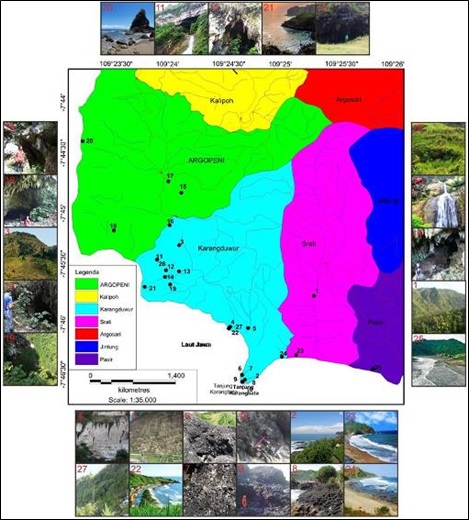Geosite Assessments at the Southern Part of Karangbolong Dome: New Insight to Geotourism Potential in Kebumen, Central Java, Indonesia
DOI:
https://doi.org/10.25299/jgeet.2020.5.1.2874Keywords:
Qualitative assessment, geodiversity, geotourism, KebumenAbstract
Karangbolong is a morphological dome in Kebumen area, that has a high geological diversity and have a lot of tourism potential, but has not been developed optimally as a geotourism potential based on conservative and educative aspects, especially the existence of ancient volcano of Menganti the quite interesting from a geological point of view, so in this case an inventory of a geological diversity is required. This study aims to understand the geological conditions and conduct an assessment of the feasibility of geodiversity in ancient volcano complex of Menganti. The methodology for this research is a direct observation in the field based on the surface geological mapping, rock sampling for petrology study of rocks for supporting the quantitative assessment of genocide in the research area. The research area has 2 (two) landscape models, ie,ex-volcanic landscape, in this case occupying 95% of the research area and then the karst landscape, occupying 5% of the research area. Stratigraphy of the research area can be divided into 5 units from old to young, that is basaltic lava of Menganti, the pyroclastic flow of Menganti which is interfingering with andesitic lava of Karangduwur, andesite-basalt intrusion unit, and limestone of Agropeni. Based on field investigation, the research area has 27 geosite objects that can be developed as geotourism potential, covering 3 geomorphological sites, 7 lithology sites, 9 cave karst sites, 5 beach sites, and 2 waterfall sites. Based on the results of quantitative assessment of geosites in the research area with accessibility, state of preservation, scientific wort, and educational significance parameters, the research area has a geodiversity index from 19 until 24, in this case, the research area has good until very good grade to be developed as a geotourism potential base on educative and conservative, in order to improve the economic value of local communities.
Keywords: Qualitative assessment, geodiversity, geotourism, paleo-volcano, Kebumen.
Downloads
References
Ansori, C., 2010. Potensi dan Genesis Mangan Di Kawasan Kars Gembong Selatan Berdasarkan Penelitian Geologi Lapangan, Analisis Data Induksi Polarisasi dan Kimia Mineral. Buletin Sumber Daya Geologi 5, 1–9.
Asikin, S., Handoyo, A., Prastistho, B., Gafoer, S., 1992. Peta Geologi Lembar Banyumas, Jawa Tengah, skala 1:100.000. Pusat Penelitian dan Pengembangan Geologi, Bandung.
Brahmantyo, B., Bandono, 2006. Klasifikasi Bentuk Muka Bumi. Geoaplika 1, 71–79.
Dowling, R. & Newsome, D., 2006. Geotourism: sustainability, impacts and management. Elsevier, Oxford.
Fadlin, Saban, G., Hamzah, W.N., 2018. Magmatisme Tholeitik pada Active Continental Margin (ACM) di Serayu Bagian Utara dan Selatan – Banyumas, Jawa Tengah. Geologi dan Sumberdaya Mineral 19, 15–30.
Gill, R., 2013. Igneous Rocks and Processes. A practical guide, First. ed, Wiley-Blackwell. Chicester-UK. https://doi.org/10.1017/CBO9781107415324.004
GoogleMap, https://www.google.co.id/maps [WWW Document]. (accessed 2018-05-22).
Gray, M., 2004. Geodiversity: Valuing and Conserving Abiotic Nature. John Wiley & Sons, Ltd, London.
Mulyaningsih, S., Hidayat, S., Rumanto, A., 2016. Seminar Nasional Ke-III. Fakultas Teknik Geologi Universitas Padjadjaran, in: Peran Geologi Dalam Pengembangan Pengelolaan Sumber Daya Alam Dan Kebencanaan.
Newsome, D., Dowling, R.K., 2010. Geotourism: The Tourism of Geology and Landscape. Goodfellow Publisher, Oxford.
Serrano, E., Ruiz-Flaño, P., 2007. Geodiversity. A theoretical and applied concept. Geographica Helvetica 62, 140–147. https://doi.org/10.5194/gh-62-140-2007
Solarska, A., Jary, Z., 2010. Geoheritage and geotourism potential of the Strzelin Hills (Sudetic Foreland, SW Poland). Geographica Pannonica 14, 118–125.
Stokes, A.M., Cook, S.D., Drew, D., 2003. Geotourism: The New Trend in Travel, National Geographic Traveler. Travel Industry Association of America, Am.
Tourtellot, J.B., 2010. Geotourism for your community. National Geographic.
Travis, B.R., 1955. Classification of rocks, Russell B. ed, Quaterly of the Colorado School Mines. Colorado School of Mines, Colorado.
Van Bemmelen, R.W., 1949. The Geology of Indonesia. General Geology of Indonesia and Adjacent Archipelagoes, First. ed. Government Printing Office, Hague.

Downloads
Published
Issue
Section
License
Copyright @2019. This is an open-access article distributed under the terms of the Creative Commons Attribution-ShareAlike 4.0 International License which permits unrestricted use, distribution, and reproduction in any medium. Copyrights of all materials published in JGEET are freely available without charge to users or / institution. Users are allowed to read, download, copy, distribute, search, or link to full-text articles in this journal without asking by giving appropriate credit, provide a link to the license, and indicate if changes were made. All of the remix, transform, or build upon the material must distribute the contributions under the same license as the original.










